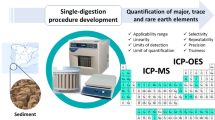Summary
Multi-element analysis by ICP source mass spectrometry for practically matrix-free natural waters, coming from a granitic area and, therefore, rich in trace elements, has been compared with ICP-atomic emission, ICP atomic fluorescence and atomic absorption spectrometry. The following elements have been investigated and their concentrations are in the decreasing order: Ca, Si, Na, Mg, K, Al; Sr, Mn, Ba, Fe, Rb, Zn, B, U, Y, Li, La, Be, Cs, Co, Cr, V, Sb, Bi, Th, Cu, Cd, Ni, Se, Pb, As, Hg, Mo, Tl, Sn. The concentration ranges were between 10 ppm and <0.01 ppb.
As a measure of agreement between the different methods under investigation, two criteria have been used (a) the relative variation coefficient VK (%) of the mean element concentration of an element, determined by different methods in all the 98 water samples and (b) the linear, logarithmic and Spearman rank correlation coefficients between ICP-MS and each of the other methods. Detection limits are given from literature for about 32 elements using different methods.
The elements Ca, Na, Mg, K, Mn, Sr, Zn, Fe, Li, Cu have been determined with ICP-MS, ICP-AES and AAS; Al, Ba with ICP-MS and ICP-AES; Si only with ICP-AES, whereas B, Be, Bi, Co, Cr, Cs, Hg, La, Mo, Ni, Pb, Rb, Sb, Sn, Th, Tl, U, V, Y only with ICP-MS. In all 34 of the investigated 36 elements could be analysed by ICP-MS, 14 (from about 20 possible) by AAS, 13 by ICP-AES and 12 by ICP-AFS.
The agreement between ICP-MS and ICP-AES as well as between ICP-MS and AAS in most cases is remarkably good according to (a). VK (%) for each element in 98 water samples is in the range from ±2.6 to 10% for Na, Mg, Ca, K, Fe, Sr, Ba, Cu, Li (increasing order). Cd and Zn have unexpectedly higher values (±17.3 and ±20.5%); Cd concentrations are, however, near the detection limit.
Comparing the different methods on the basis of correlation coefficients according to (b), gives for the Spearman rank correlation coefficient over the whole range of concentrations, respectively for ICP-MS/ICP-AES, AAS, ICP-AFS in case of Ca: 0.998; 0.984; 0.899; Na: 0.993; 0.991; 0.978; Mg: 0.997; 0.993; 0.959; K: 0.986; 0.942; 0.677; Al: 0.987; -; -; Fe: 0.864; 0.974; 0.701; Mn: 0.989; 0.990; 0.198; Sr: 0.988; 0.992; -; Zn: 0.894; 0.819; 0.300; Cu: -; 0.977; 0.202; Li: -; 0.907; 0.586.
It is evident from these trace element concentrations as well as the electrical conductivities, that only about three fourths of the investigated samples are typical granitic waters and the remaining ones are associated with different geological background. The samples have been mainly radon waters with more than 18 nCi/l of Rn-222.
Similar content being viewed by others

References
Brunner W, Sansoni B, Wolff G, Panday VK, Ruppert H, Dittrich R (1988) Jülich-Bericht (in preparation)
Carlé W (1975) Die Mineral- und Thermalwässer von Mittel-europa. Geologie, Chemismus, Genese. Wissenschaftliche Verlagsgesellschaft mbH, Stuttgart
Gray AL (1974) Proc Soc Anal Chem 11:182–3; Analyst 100:289–299
Gray AL (1985) The potential of ICP source mass spectrometry. In: Sansoni B (ed) Instrumentelle Multielementanalyse. VCH-Verlagsgesellschaft, Weinheim, pp 227–236
Houk RS, Fassel VA, Flesch GD, Svec HJ, Gray AL, Taylor CE (1980) Anal Chem 52:2283–2289
International Workshop on Chemical Analysis Service, Aachen, April 5–7, 1984. Fresenius Z Anal Chem (1986) 232:533–627
Matthe\ G (1973) Die Beschaffenheit des Grundwassers. Gebrüder Borntraeger, Berlin
Nn (1981) Analytische Methoden für die Atomabsorptions-Spektroskopie. Perkin-Elmer, Bestell-Nr. B 321, Bodenseewerk Perkin-Elmer & Co, GmbH, überlingen
Sansoni B (1982) Natural high background areas at Fichtelgebirge. Areas of higher natural radioactivity I. In: Vohra KG, Mishra UC, Pillai KC, Sadasivan S (eds) Wiley, New Dehli, pp 74–84
Sansoni B (ed) (1985) Instrumentelle Multielementanalyse. VCH-Verlagsgesellschaft, Weinheim, p 782
Sansoni B (1985) Einführung in die Instrumentelle Multielementanalyse. In: Sansoni B (ed) Instrumentelle Multielementanalyse. VCH-Verlagsgesellschaft, Weinheim, pp 3–56
Sansoni B (1987) Pure Appl Chem 59:579–610
Sansoni B (1986) Fresenius Z Anal Chem 323:615–627
Sansoni B, Matthes W (1985) Gebiete mit erhöhter natürlicher Radioaktivität. III. Strahlungs-, Uran- und Radonanomalien im Fichtelgebirge. Jülich-Bericht Spez. Nr 334 (ISSN-0343-7639), p 62
Sansoni B, Matthes W, Schnitzler J (1986) Gebiete mit erhöhter natürlicher Radioaktivität. IV. Radon-222-, Radium-226- und Urankonzentration in Oberflächen-, Grund- und Trinkwasser im Fichtelgebirge. Ergebnisse der Me\fahrt Mai/Juni 1984. Jülich-Bericht 2063 (ISSN-0366-0885)
Sudgen TM (1965) In: Reed RI (ed) Mass spectrometry. Academic Press, New York, pp 347–358
Wolff G, Nickel H, Lippert H (1985) Einsatz eines simultanen ICP-Spektrometers im Analysendienst eines Forschungs-zentrums. In: Sansoni B (ed) Instrumentelle Multielementanalyse. VCH-Verlagsgesellschaft, Weinheim, pp 647–656
Author information
Authors and Affiliations
Additional information
Dedicated to Professor Dr. H. Kelker, Frankfurt, on the occasion of his 65th birthday
6th Contribution to the principles of trace analysis of elements and radionuclides
Rights and permissions
About this article
Cite this article
Sansoni, B., Brunner, W., Wolff, G. et al. Comparative instrumental multi-element analysis I: Comparison of ICP source mass spectrometry with ICP atomic emission spectrometry, ICP atomic fluorescence spectrometry and atomic absorption spectrometry for the analysis of natural waters from a granite region. Z. Anal. Chem. 331, 154–169 (1988). https://doi.org/10.1007/BF01105160
Received:
Issue Date:
DOI: https://doi.org/10.1007/BF01105160


